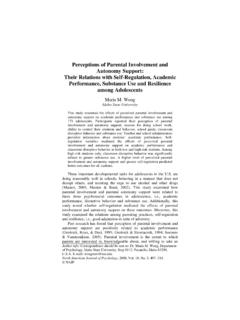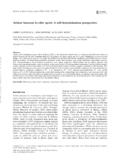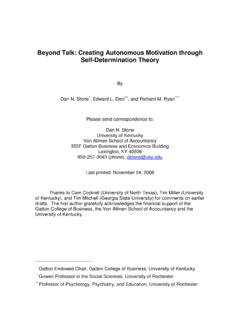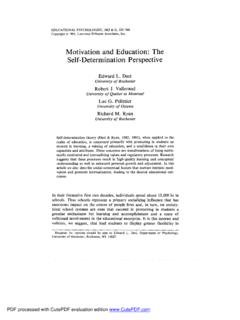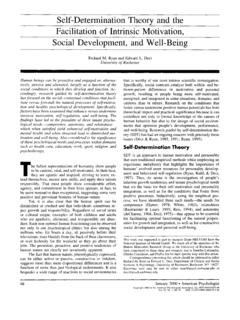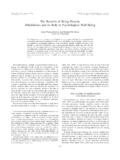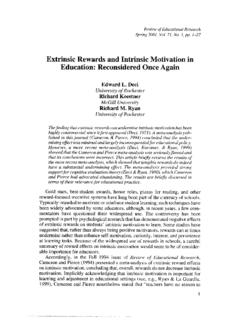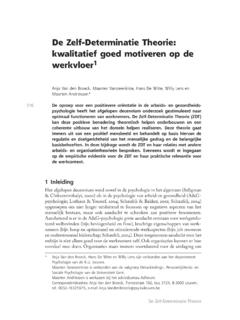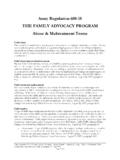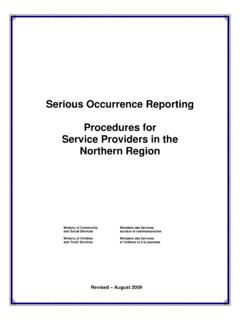Transcription of MOTIVATIONAL INTERVIEWING AND …
1 MARKLAND ET INTERVIEWINGMOTIVATIONAL INTERVIEWING ANDSELF DETERMINATION THEORYDAVID MARKLANDU niversity of Wales, BangorRICHARD M. RYANU niversity of Rochester, NYVANNESSA JAYNE TOBINU niversity of Wales, BangorSTEPHEN ROLLNICKU niversity of Wales College of MedicineMotivational INTERVIEWING has become widely adopted as a counseling style for pro-moting behavior change; however, as yet it lacks a coherent theoretical frameworkfor understanding its processes and efficacy. This article proposes that self determi-nation theory (SDT) can offer such a framework. The principles of MOTIVATIONAL inter-viewing and SDT are outlined and the parallels between them are drawn out.
2 Weshow how both MOTIVATIONAL INTERVIEWING and SDT are based on the assumption thathumans have an innate tendency for personal growth toward psychological integra-tion, and that MOTIVATIONAL INTERVIEWING provides the social environmental facilitat-ing factors suggested by SDT to promote this tendency. We propose that adopting anSDT perspective could help in furthering our understanding of the psychologicalprocesses involved in MOTIVATIONAL INTERVIEWING has become widely adopted as a counselingstyle for facilitating behavior change. Having evolved originally fromclinical experience in the treatment of problem drinking, MOTIVATIONAL in-terviewing was first described by Miller (1983).
3 Its principles and clinicalprocedures were expanded upon by Miller and Rollnick (1991, 2002). Mo-tivational INTERVIEWING and adaptations of MOTIVATIONAL interviewingJournal of Social and Clinical Psychology, Vol. 24, No. 6, 2005, pp. 811-831811 Please address correspondence to David Markland, PhD, C. Psychol., University ofWales, Bangor; School of Sport, Health and Exercise Sciences; George Building; HolyheadRoad; Bangor, Gwynedd, UK; LL57 2PZ; E mail: have been extended to a wide range of behavior change contexts,including other drugs of misuse ( , van Bilsen, 1991; Saunders,Wilkinson, & Allsop, 1991; Stephens, Roffman, & Curtin, 2000), HIV pre-vention among drug users (Baker, Kochan, Dixon, Heather, & Wodak,1994), smoking cessation ( , Rollnick, Butler, & Stott, 1997; Butler et al.)
4 ,1999), sex offending (Garland & Dougher, 1991), and a variety of otherhealth behaviors, particularly in medical settings ( , Jensen, 1996;Rollnick, Kinnersley, & Stott, 1993; Rollnick, Mason, & Butler, 1999; Stott,Rollnick, Rees, & Pill, 1995). Systematic reviews of the efficacy of motiva-tional INTERVIEWING and AMIs (Burke, Arkowitz, & Dunn, 2002; Dunn,DeRoo, & Rivara, 2001; Noonan & Moyers, 1997; Resnicow et al., 2002)have concluded that, despite methodological problems in many of thestudies, the literature provides converging evidence for reasonably con-sistent and robust effects of AMIs across a variety of behavioral domains,particularly those involving alcohol and other (1983) described MOTIVATIONAL INTERVIEWING as being based on theprinciples of experimental social psychology, drawing on the concepts ofcausal attributions, cognitive dissonance, and self efficacy.
5 Motivationalinterviewing has been also closely aligned with Prochaska andDiClemente s (1983) transtheoretical model of behavior change(DiClemente & Velasquez, 2002; Miller & Rollnick, 1991) and the conceptof readiness to change (Rollnick & Miller, 1995). However, while variousaspects of the principles and practice of MOTIVATIONAL INTERVIEWING havebeen linked to a variety of social psychological and social cognitive mod-els, this has been largely on a piecemeal and descriptive basis. Motiva-tional INTERVIEWING has been criticized for being essentially atheoretical(Draycott & Dabbs, 1998).
6 Indeed, Miller (1994, 1996, 1999) has acknowl-edged that so far little attention has been paid to developing a theoreticalunderpinning to MOTIVATIONAL INTERVIEWING and that as yet there is no sat-isfactory explanation as to how and why it can be effective. More recently,Foote et al. (1999) and Ginsberg, Mann, Rotgers, and Weekes (2002) pro-posed that MOTIVATIONAL INTERVIEWING can be conceptualized and in-formed by self determination theory (SDT; Deci & Ryan, 1985, 1991). Theaim of this paper is to expand on their suggestions and argue that SDT of-fers the possibility of providing a useful theoretical framework for under-standing MOTIVATIONAL INTERVIEWING s efficacy.
7 Furthermore, it is pro-posed that a consideration of MOTIVATIONAL INTERVIEWING from aself determination theory perspective will help in reaching a betterunderstanding of the processes involved, which could inform futuredevelopments and research into its methods and ET PRINCIPLES OF MOTIVATIONAL INTERVIEWINGM otivational INTERVIEWING is defined as a client centered, directivemethod for enhancing intrinsic motivation to change by exploring and re-solving ambivalence (Miller & Rollnick, 2002, p. 25). Thus the recogni-tion of client ambivalence plays a central role in motivationalinterviewing.
8 It is assumed that most clients entering counseling will holdconflicting motivations. On theone hand they have good reasons tochange their current behaviors but on the other hand they are aware thatthere are benefits and costs associated with both changing and staying thesame. This decisional conflict can result in the client being stuck in a statein which they are unable to change despite there being incentives to do so,or to alternate between engaging ina new behavior pattern and relapsingto old behaviors. It is claimed that attempting to directly persuade a clientto change will be ineffective because it entails taking one side of the con-flict which the client is already experiencing.
9 The result is that the clientmay adopt the opposite stance, arguing against the need for change,thereby resulting in increased resistance and a reduction in the likelihoodof change (Miller & Rollnick, 1991; Miller, Benefield & Tonigan, 1993;Rollnick & Miller, 1995). Instead, MOTIVATIONAL INTERVIEWING allows the cli-ent to overtly express their ambivalence in order to guide them to a satis-factory resolution of their conflicting motivations with the aim oftriggering appropriate behavioral changes (Rollnick & Miller, 1995).A key assumption underlying MOTIVATIONAL INTERVIEWING , then, is thatit is not the counselor s function to directly persuade or coerce the clientto change.
10 Rather it is the client s responsibility to decide for themselveswhether or not to change and how best to go about it. The counselor srole in the process is to help the client locate and clarify their motivationfor change, providing information and support and offering alternativeperspectives on the problem behavior and potential ways of changing(Miller, 1983).It follows that MOTIVATIONAL INTERVIEWING is by definition a client cen-tered counseling style, and Miller and Rollnick (1991, 2002) acknowl-edge the debt it owes to Carl Rogers person centered INTERVIEWING differs, however, from the traditionalRogerian approach in that it is also intentionally directive (Miller andRollnick, 1991, 2002; Resnicow et al.)
